Cats Butt is Red, at Cat Karma Creations, we understand the importance of keeping your feline friend healthy and happy. Discover the common causes and symptoms of a cat’s red butt, and learn how to treat and prevent this uncomfortable condition. Whether you’re a new or experienced cat owner, this guide will provide you with the essential information to ensure your cat’s well-being and comfort. By understanding the signs and taking proactive steps, you can help your cat live a happier, healthier life.
If you have any questions or need further assistance, feel free to contact us or reach out via phone at (800) 343-1604.
Common Causes of a Cat’s Red Butt
Understanding the root causes of a cat’s red butt is crucial for effective treatment and prevention. Several factors can contribute to this condition, including allergies, infections, and dietary issues. Let’s delve into each of these causes in more detail.
Allergies and Irritants
Allergies can cause a cat’s butt to become red and irritated. Common allergens include food, pollen, and flea bites. When a cat is allergic to these substances, their immune system overreacts, leading to inflammation and redness. Fleas, in particular, can cause significant irritation, as their saliva is highly allergenic. If you suspect your cat has an allergy, it’s essential to identify and eliminate the allergen. Regular vet check-ups can help diagnose and manage allergies effectively.
Infections and Parasites
Infections and parasites are another common cause of a red cat butt. Bacterial, viral, and fungal infections can all lead to redness, swelling, and discomfort. Parasites like fleas, ticks, and mites can also cause irritation and inflammation. These tiny pests can burrow into the skin, causing sores and secondary infections. Regular flea treatments and good hygiene practices can help prevent these issues. If you notice signs of infection, such as fever or discharge, consult a veterinarian for appropriate treatment.
Diet and Digestive Issues
Your cat’s diet can play a significant role in the health of their skin and overall well-being. Certain foods can cause digestive issues that manifest as a red butt. For example, a diet high in allergens or irritants can lead to inflammation and irritation. Foods that are difficult to digest can also cause diarrhea, which can irritate the skin around the anal area. Adjusting your cat’s diet to include high-quality, easily digestible foods can help prevent these issues. Consult with a veterinarian to determine the best diet for your cat.
Symptoms of a Cat’s Red Butt
Recognizing the symptoms of a red cat butt is essential for timely treatment. Common signs include itching, swelling, and discharge. If you notice any of these symptoms, it’s important to act quickly to alleviate your cat’s discomfort and prevent further complications.
Itching and Scratching
One of the most common symptoms of a red cat butt is itching. If your cat is constantly scratching or licking their rear end, it could be a sign of irritation or infection. Allergies, parasites, and skin conditions can all cause itching. To provide relief, you can try using gentle, hypoallergenic shampoos and keeping the area clean and dry. If the itching persists, consult a veterinarian for further evaluation.
Swelling and Redness
Swelling and redness are other common symptoms of a red cat butt. These signs can indicate inflammation or infection. Swelling may be accompanied by heat and pain, making it uncomfortable for your cat to sit or move. To reduce swelling, you can apply cool compresses to the affected area. However, if the swelling is severe or accompanied by other symptoms, it’s important to seek veterinary care.
Discharge and Bleeding
Discharge and bleeding are more serious symptoms that can indicate a deeper issue. If you notice any discharge, such as pus or blood, it’s important to seek veterinary attention immediately. Discharge can be a sign of infection, parasites, or other underlying health problems. Bleeding can be caused by irritation, sores, or even more serious conditions like anal sac issues. Your veterinarian can perform a thorough examination and recommend the appropriate treatment.
Treating a Cat’s Red Butt
Once you’ve identified the cause of your cat’s red butt, it’s time to start treatment. There are several options available, ranging from home remedies to veterinary interventions. The key is to address the underlying issue and provide relief for your cat.
Home Remedies and Natural Treatments
Many cat owners find success with home remedies and natural treatments for a red cat butt. Some effective options include:
- Aloe vera: This natural plant has anti-inflammatory properties and can help soothe irritated skin. Apply a small amount of aloe vera gel to the affected area.
- Coconut oil: Known for its moisturizing and antibacterial properties, coconut oil can help reduce redness and irritation. Gently apply a small amount to the area.
- Chamomile tea: Chamomile has calming and anti-inflammatory effects. Brew a weak chamomile tea and let it cool before applying it to your cat’s red butt with a clean cloth.
While these remedies can provide temporary relief, it’s important to address the underlying cause of the redness. If symptoms persist, consult a veterinarian for further treatment.
Over-the-Counter Medications
Over-the-counter medications can also be effective for treating a red cat butt. Antihistamines can help reduce itching and inflammation caused by allergies. Topical creams and ointments, such as corticosteroids, can provide relief for skin irritation and inflammation. However, it’s important to use these medications under the guidance of a veterinarian to ensure they are safe and appropriate for your cat.
Veterinary Treatments and Prescriptions
In some cases, veterinary intervention is necessary to treat a red cat butt. Your veterinarian may prescribe antibiotics, antifungals, or other medications to address infections or parasites. They may also recommend flea treatments, dietary changes, or other interventions to manage the underlying cause. Regular follow-up appointments can help monitor your cat’s progress and ensure they are responding well to treatment.
Preventing a Cat’s Red Butt
The best way to manage a red cat butt is to prevent it from happening in the first place. By taking proactive steps, you can reduce the risk of irritation and inflammation. Here are some key strategies for prevention:
Maintaining Good Hygiene
Good hygiene is essential for preventing a red cat butt. Regular grooming and cleaning can help keep your cat’s skin and coat healthy. Use gentle, hypoallergenic shampoos and avoid harsh chemicals that can irritate the skin. After bathing, make sure to dry your cat thoroughly to prevent moisture buildup. Regularly cleaning your cat’s litter box can also help reduce the risk of infections and parasites.
Balanced Diet and Nutrition
A balanced diet is crucial for your cat’s overall health and skin condition. High-quality, easily digestible foods can help prevent digestive issues that may lead to a red butt. Avoid feeding your cat foods that are high in allergens or irritants. Consult with a veterinarian to determine the best diet for your cat’s specific needs. Additionally, consider adding supplements like omega-3 fatty acids to support skin health.
Regular Vet Check-Ups
Regular veterinary check-ups are essential for monitoring your cat’s health and catching issues early. Your veterinarian can perform thorough examinations and recommend appropriate treatments. Early intervention can help prevent minor issues from becoming more serious. Don’t hesitate to schedule an appointment if you notice any changes in your cat’s behavior or health.
Popular Quote
“Cats are connoisseurs of comfort.” – James Herriot
This quote beautifully captures the essence of a cat’s need for a comfortable and healthy environment. Ensuring your cat’s comfort is a key aspect of preventing and treating a red butt.
Statistical Fact
According to the American Veterinary Medical Association (AVMA), approximately 30% of cats suffer from skin allergies, which can often manifest as a red and irritated butt. This statistic underscores the importance of regular vet check-ups and proactive care to manage and prevent such conditions.
Three Tips for Preventing a Cat’s Red Butt
- Regular Grooming: Brush your cat’s fur regularly to remove loose hair and prevent matting, which can irritate the skin. Use a soft-bristled brush and be gentle around sensitive areas.
- Healthy Diet: Feed your cat a high-quality, balanced diet that is free from common allergens. Consult with a veterinarian to determine the best diet for your cat’s specific needs.
- Parasite Control: Use regular flea and tick treatments to prevent infestations that can cause irritation and inflammation. Check your cat’s skin and fur regularly for signs of parasites.
Popular Questions
- What are the most common causes of a red cat butt? The most common causes include allergies, infections, and dietary issues. Fleas, pollen, and certain foods can trigger allergic reactions, while bacteria, viruses, and parasites can cause infections.
- How can I tell if my cat has a red butt? Look for signs of redness, swelling, itching, and discharge. If your cat is frequently licking or scratching their rear end, it could be a sign of irritation or infection.
- What home remedies can I use to treat a red cat butt? Aloe vera, coconut oil, and chamomile tea are natural remedies that can provide temporary relief. However, it’s important to address the underlying cause of the redness.
- When should I take my cat to the vet for a red butt? If the redness is severe, accompanied by other symptoms like fever or discharge, or if home remedies are not effective, it’s important to seek veterinary care.
- How can I prevent a red cat butt? Maintain good hygiene, feed a balanced diet, and use regular parasite control. Regular vet check-ups can also help catch and treat issues early.
Final Thoughts About a Cat’s Red Butt
A cat’s red butt can be a sign of various underlying issues, but with the right knowledge and care, you can effectively manage and prevent this condition. By staying vigilant and taking proactive steps, you can ensure your cat remains healthy and comfortable. If you have any concerns, don’t hesitate to contact us or reach out via phone at (800) 343-1604. We’re here to support you and your feline friend every step of the way.
At Cat Karma Creations, we are committed to providing high-quality, unique cat-themed jewelry and gifts. Our in-house jewelry designer, Jules, creates imaginative and exclusive pieces that reflect our love for cats and our Welsh and Canadian roots. We also collaborate with cat rescue charities to support feline welfare. Explore our diverse product range and find the perfect gift for any occasion. For custom orders or inquiries, please visit our contact form or send an email to info@catkarmacreations.com.
| Feature | Allergies | Infections | Parasites | Irritation |
|---|---|---|---|---|
| Common Causes | Food, pollen, fleas | Bacteria, viruses, fungi | Fleas, ticks, mites | Harsh chemicals, poor hygiene |
| Symptoms | Itching, redness, swelling | Fever, discharge, pain | Itching, redness, sores | Redness, swelling, itching |
| Prevention | Avoid allergens, regular vet check-ups | Good hygiene, vaccinations | Regular flea treatments | Use gentle products, regular cleaning |
| Treatment | Antihistamines, corticosteroids | Antibiotics, antifungals | Flea treatments, topical medications | Cool compresses, soothing creams |















